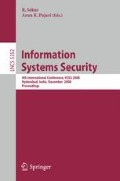Abstract
Internet voting will probably be one of the most significant achievements of the future information society. It will have an enormous impact on the election process making it fast, reliable and inexpensive. Nonetheless, so far the problem of providing security of remote voting is considered to be very difficult, as one has to take into account susceptibility of the voter’s PC to various cyber-attacks. As a result, most of the research effort is put into developing protocols and machines for poll-site electronic voting. Although these solutions yield promising results, most of them cannot be directly applied to Internet voting because of the secure platform problem. However, the cryptographic components they utilize may be very useful in the context of remote voting, too. This paper presents a scheme based on combination of mixnets and homomorphic encryption borrowed from robust poll-site voting, along with techniques recommended for remote voting – code sheets and test ballots. The protocol tries to minimize the trust put in voter’s PC by employing paper ballots distributed before elections. The voter uses the ballot to submit an encrypted vote, which is illegible for the potentially corrupt PC. The creation of paper ballots, as well as the decryption of votes, is performed by a group of cooperating trusted servers. As a result, the scheme is characterized by strong asymmetry – all computations are carried out on the server side. Hence, it does not require any additional hardware on the voter’s side. Furthermore, the scheme offers distributed trust, receipt-freeness and verifiability.
Supported by Ministry of Science and Higher Education, grant N N206 2701 33, 2007-2010.
Access this chapter
Tax calculation will be finalised at checkout
Purchases are for personal use only
Preview
Unable to display preview. Download preview PDF.
References
Schneier, B.: Beyond fear: Thinking sensibly about security in an uncertain world. Copernicus Books (2003)
CIVTF: A report on the feasibility of internet voting (2000), http://www.ss.ca.gov/executive/ivote/final_report.htm
Oppliger, R.: How to address the secure platform problem for remote internet voting. In: Proceedings 5th Conf. on Security in Information Systems (SIS 2002), pp. 153–173 (2002)
Chaum, D.: Secret-ballot: True voter verifiable elections. IEEE Security and Privacy, 38–47 (2004)
Neff, A.: A verifiable secret shuffle and its application to e-voting. In: Samarati, P. (ed.) ACM CCS 2001, pp. 116–125. ACM Press, New York (2001)
Klonowski, M., Kutyłowski, M., Lauks, A., Zagórski, F.: A practical voting scheme with receipts. In: Zhou, J., López, J., Deng, R.H., Bao, F. (eds.) ISC 2005. LNCS, vol. 3650, pp. 490–497. Springer, Heidelberg (2005)
Adida, B., Rivest, R.L.: Scratch and Vote: Self-contained paper-based cryptographic voting. In: Dingledine, R., Yu, T. (eds.) ACM Workshop on Privacy in the Electronic Society. ACM Press, New York (2006)
Ryan, P., Schneider, S.: Prêt à Voter with re-encryption mixes. In: Gollmann, D., Meier, J., Sabelfeld, A. (eds.) ESORICS 2006. LNCS, vol. 4189, pp. 313–326. Springer, Heidelberg (2006)
Popovenuic, S., Hosp, B.: An introduction to punchscan. In: IAVoSS Workshop On Trustworthy Elections, WOTE (2006)
van de Graaf, J.: Merging prêt à voter and punchscan (2007), http://eprint.iacr.org/2007/269.pdf
Xia, Z., Schneider, S., Heather, J.: Analysis, improvement and simplification of Prêt à Voter with paillier encryption. In: USENIX/ACCURATE Electronic Voting Technology Workshop (2008)
Rubin, A.: Security considerations for remote electronic voting over the internet (2001), http://avirubin.com/e-voting.security.pdf
SureVote: E-voting system - overview (2001), http://www.vote.caltech.edu/wote01/pdfs/surevote.pdf
Lee, B., Kim, K.: Receipt-free electronic voting scheme with a tamper-resistant randomizer. In: Lee, P.J., Lim, C.H. (eds.) ICISC 2002. LNCS, vol. 2587, pp. 389–406. Springer, Heidelberg (2003)
Kutyłowski, M., Zagórski, F.: Verifiable internet voting solving secure platform problem. In: Miyaji, A., Kikuchi, H., Rannenberg, K. (eds.) IWSEC 2007. LNCS, vol. 4752, pp. 199–213. Springer, Heidelberg (2007)
Clarkson, M.R., Chong, S., Myers, A.C.: Civitas: Toward a secure voting system. In: 2008 IEEE Symposium on Security and Privacy, pp. 354–368 (2008)
Young, A., Yung, M.: The dark side of black-box cryptography, or: Should we trust Capstone? In: Koblitz, N. (ed.) CRYPTO 1996. LNCS, vol. 1109. Springer, Heidelberg (1996)
Estonian National Election Committee: E-voting system - overview (2006), http://www.vvk.ee/elektr/docs/Yldkirjeldus-eng.pdf
Chaum, D., Pedersen, T.: Wallet databases with observers. In: Brickell, E.F. (ed.) CRYPTO 1992. LNCS, vol. 740, pp. 89–105. Springer, Heidelberg (1993)
Park, C., Itoh, Kh., Kurosawa, K.: Efficient anonymous channel and all/nothing election scheme. In: Helleseth, T. (ed.) EUROCRYPT 1993. LNCS, vol. 765, pp. 248–259. Springer, Heidelberg (1994)
Jakobsson, M., Juels, A., Rivest, R.L.: Making mix nets robust for electronic voting by randomized partial checking. In: USENIX Security Symposium, pp. 339–353 (2002)
Author information
Authors and Affiliations
Editor information
Editors and Affiliations
Rights and permissions
Copyright information
© 2008 Springer-Verlag Berlin Heidelberg
About this paper
Cite this paper
Nitschke, Ł. (2008). Secure Internet Voting Based on Paper Ballots. In: Sekar, R., Pujari, A.K. (eds) Information Systems Security. ICISS 2008. Lecture Notes in Computer Science, vol 5352. Springer, Berlin, Heidelberg. https://doi.org/10.1007/978-3-540-89862-7_7
Download citation
DOI: https://doi.org/10.1007/978-3-540-89862-7_7
Publisher Name: Springer, Berlin, Heidelberg
Print ISBN: 978-3-540-89861-0
Online ISBN: 978-3-540-89862-7
eBook Packages: Computer ScienceComputer Science (R0)

